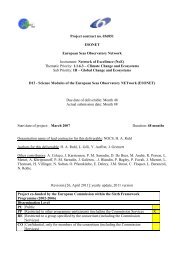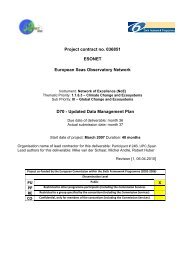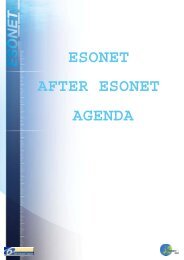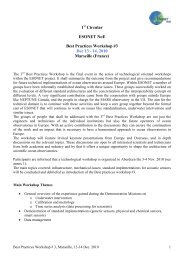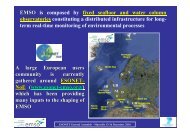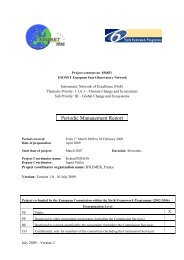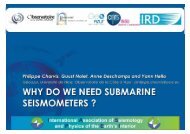Project Deliverable D50 Report on Best Practices ... - ESONET NoE
Project Deliverable D50 Report on Best Practices ... - ESONET NoE
Project Deliverable D50 Report on Best Practices ... - ESONET NoE
Create successful ePaper yourself
Turn your PDF publications into a flip-book with our unique Google optimized e-Paper software.
In the marine envir<strong>on</strong>ment a diversity of sounds is typically found. Physical processes, marine<br />
organisms and human activities generally c<strong>on</strong>tribute to produce these sound sources.<br />
This c<strong>on</strong>stitutes a challenging envir<strong>on</strong>ment for automated classifiers because (1) the target<br />
sources are often embedded in background noise (2) n<strong>on</strong>-target sources can cause false<br />
detecti<strong>on</strong>s or c<strong>on</strong>versely attenuate the detecti<strong>on</strong> of the target sources. There is a need of<br />
developing a system for the detecti<strong>on</strong> of many acoustic events relevant to the m<strong>on</strong>itoring and<br />
study of the interacti<strong>on</strong>s between cetaceans and anthropogenic sounds. The system is to be<br />
used for the l<strong>on</strong>g-term data (several m<strong>on</strong>ths or years) assessment. It should tag segments that<br />
c<strong>on</strong>tain acoustic events of a particular class, allowing for example (1) mitigati<strong>on</strong> acti<strong>on</strong>s to be<br />
undertaken, (2) to obtain l<strong>on</strong>g time series of the occurrence of a particular sound, (3) to avoid<br />
the unnecessary storage or transmissi<strong>on</strong> of data that c<strong>on</strong>tains n<strong>on</strong>e of the events of interest.<br />
The output of the Dem<strong>on</strong>strati<strong>on</strong> Missi<strong>on</strong> LIDO is providing such a system in the form of a<br />
modular architecture that is ensuring the real-time process of the data. The challenge is here to<br />
be able to find a reliable set of filters or detectors able to extract the interesting informati<strong>on</strong><br />
that would be superimposed to background-noise, like dolphin calls and s<strong>on</strong>ar, sperm and<br />
beaked whale clicks, or noise produced by ship engine.<br />
A schematic overview of the classificati<strong>on</strong> system is described in the following text. The<br />
audio data stream is processed by segments of 22 sec<strong>on</strong>ds. The output of the system takes the<br />
form of tags, which are appended to a segment if the corresp<strong>on</strong>ding acoustic event is detected.<br />
The first stage of the system detects broad classes of events. The sec<strong>on</strong>d stage classifies<br />
segments into more specific classes. The system’s modules can be run independently, thereby<br />
allowing to implement smaller and faster versi<strong>on</strong>s, aimed at specific classes of sounds or<br />
mitigati<strong>on</strong> scenarios, like the detecti<strong>on</strong> and tracking of specific whale species, the presence of<br />
ships or other human activities. New modules can be incorporated into the system.<br />
The system is being specifically designed to be adapted to different scenarios, shallow vs.<br />
deep waters, different background noise, different human activities, different marine mammal<br />
species, etc., following standard procedures in compliance with the GEOSS guidelines for<br />
interoperability, the standard sensor registrati<strong>on</strong> and discoverability of acoustic sensors.<br />
4.3 Infrastructure<br />
4.3.1 Design comparis<strong>on</strong> – Cabled observatories<br />
4.3.1.1 Introductory text<br />
Several subsea cabled observatories are operated or under final c<strong>on</strong>structi<strong>on</strong>. Some elements<br />
were presented during the First <strong>Best</strong> Practice Workshop in Bremen. This panel will update<br />
this informati<strong>on</strong>.<br />
The cost evaluati<strong>on</strong> performed by <strong>ESONET</strong> WP5 group will be reviewed and compared with<br />
standal<strong>on</strong>e soluti<strong>on</strong>s. The panel will look more carefully at <strong>on</strong>e case, taking into account the<br />
scientific objectives presented earlier in the week at the All Regi<strong>on</strong>s Workshop 2 in Paris.<br />
System engineering issues for the various comp<strong>on</strong>ents of the infrastructure will be addressed.<br />
For the remaining integrati<strong>on</strong> budget in <strong>ESONET</strong>, the Steering Committee decided to open a<br />
call for the partners. The main objective of the call is to promote test of equipment and<br />
instruments <strong>on</strong> cabled subsea observatory sites. The results of the two Dem<strong>on</strong>strati<strong>on</strong> Missi<strong>on</strong><br />
Calls of <strong>ESONET</strong> showed a lack in the field of cabled observatories experiment.<br />
A unified proposal for test <strong>on</strong> cabled sites is under final acceptance process. It will be<br />
presented to the panel for discussi<strong>on</strong> and suggesti<strong>on</strong> according to the practices of the<br />
<str<strong>on</strong>g>Deliverable</str<strong>on</strong>g> #50 - update October 2010 11



